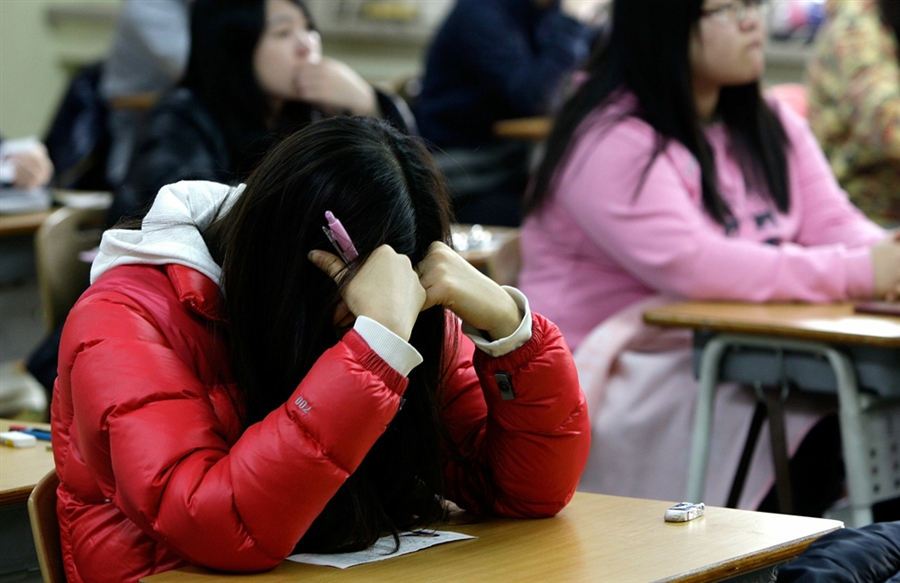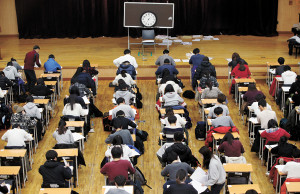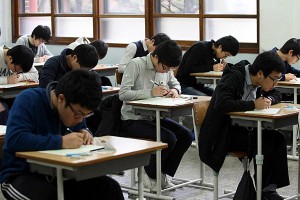 On November 12th, planes were temporarily grounded, work was delayed, cheer groups lined the roads, prayer circles were held, and the majority of the nation held its breath as approximately 630,000 students took the College Scholastic Aptitude Test — or Suneung. The test, offered only once a year, is seen as the make or break exam not only when it comes to college admissions, but also a teenager’s entire future.
On November 12th, planes were temporarily grounded, work was delayed, cheer groups lined the roads, prayer circles were held, and the majority of the nation held its breath as approximately 630,000 students took the College Scholastic Aptitude Test — or Suneung. The test, offered only once a year, is seen as the make or break exam not only when it comes to college admissions, but also a teenager’s entire future.
Alongside the masses of High School seniors, were also a few K-pop celebrities who took the exam as more of a rite of passage than a gateway to a good college. While some JYP idols sat out the test this year (Park Jimin and Twice‘s Jihyo) to focus on their career, GOT7‘s Yugyeom did sit for the exam. Many other rookie group members also took the exam this year, including: G-Friend‘s Yuju and Sowon, Seventeen‘s Mingyu, DK and Seungkwan, DIA‘s Chaeyeon, Eunjin and Yebin, Oh My Girl‘s Jiho and Binnie, and April‘s Chaewon, to name a few.
While the Suneung isn’t something all idols choose to endure, every November many idols take to social media to cheer on not only their label-mates, but all students preparing for the exam.
Taking place over the course of eight hours, the notoriously challenging College Scholastic Aptitude Test (CSAT) is understood as the ticket to a position in a top university — preferably one of the SKY Universities (Seoul National University, Korea University and Yonsei University) — and ultimately a better job in the future. With more than 80% of South Korean high school students continuing on to higher education, positions in these universities become more and more sought after each year.
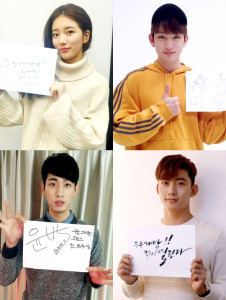 High school students spend years preparing for this exam, both in and outside of school. Hagwon (private academy) schooling begins as young as preschool and only becomes more intense with age. Similarly, the hours of study increase each year, with daily study hours sometimes exceeding 13 daily by high school. Korean students already spend 220 days a year in school (compared to 180 for the U.S.), but school “vacations” are more often than not also spent in hagwons the closer one gets to their final year of high school. By the time students reach November of their “hell year” and the CSAT exam, they have been pushed to their limits both physically and mentally to prepare for a single test that will ‘determine their future.’ With so much significance placed on a single test — and the fact that it is only offered once a year — CSAT season unfortunately also becomes a particularly high time for suicides.
High school students spend years preparing for this exam, both in and outside of school. Hagwon (private academy) schooling begins as young as preschool and only becomes more intense with age. Similarly, the hours of study increase each year, with daily study hours sometimes exceeding 13 daily by high school. Korean students already spend 220 days a year in school (compared to 180 for the U.S.), but school “vacations” are more often than not also spent in hagwons the closer one gets to their final year of high school. By the time students reach November of their “hell year” and the CSAT exam, they have been pushed to their limits both physically and mentally to prepare for a single test that will ‘determine their future.’ With so much significance placed on a single test — and the fact that it is only offered once a year — CSAT season unfortunately also becomes a particularly high time for suicides.
This obsession surrounding the exams is part of the larger culture of the country, one that is firmly rooted in academic — and, thereby, economic — success. Teenagers are told that by doing well on the exam, that means you’ll get a spot at one of the top three or four Korean Universities, then get a job at a top company — Samsung or Hyundai, generally.
College entrance exams are nothing new, nor are they unique to South Korea. However, the emphasis and importance placed on the CSAT — where it becomes a defining moment in a young adult’s life — does set it apart from other countries. How did the test come to bear such significance that an entire nation waits with bated breath for an entire day every November? Like most matters when it comes to South Korea, it’s a good mix of traditional history and the impact of industrialization that has shaped not only an education system centered around a single exam, but also the larger ‘education craze’ that South Korea has become known for.
Joseon Dynasty State Exams
Korea has a long standing history of state testing and strong investment in education, as such, South Korea’s education craze did not begin in the 20th century. In fact, state issued exams date as far back as the latter years of the Three Kingdoms period in Korean history. By the time of the Joseon Dynasty (1392) the state held exams that were considered just as ‘make-or-break’ as the CSAT. Tests were held to determine both vocation and social position. Depending on the desired vocation of the test-taker, citizens — aristocracy and peasants like — could spend years studying to pass any particular state exam, and ultimately raise their rank within society.
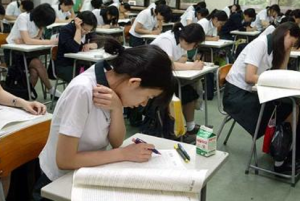 The most prestigious and revered of all these exams was the Gwageo, or Civil Service Exam (modeled after the Chinese Imperial Examinations), which was offered only once every three years. Passing the Gwageo would not only unlock the test-taker a position in aristocracy or government, but ensured a high status for both the test-taker and their family within the social hierarchy of the Confucian order — for a certain amount of generations at least.
The most prestigious and revered of all these exams was the Gwageo, or Civil Service Exam (modeled after the Chinese Imperial Examinations), which was offered only once every three years. Passing the Gwageo would not only unlock the test-taker a position in aristocracy or government, but ensured a high status for both the test-taker and their family within the social hierarchy of the Confucian order — for a certain amount of generations at least.
The Gwageo was a test so comprehensive and difficult that families would spend their entire savings to send their sons to Seoul to study for years before braving the test. Since nearly any male citizen was allowed to take the test, many families saw the examination as a chance to improve their status, which made it very much worth the investment. Takers of the Gwageo had to demonstrate a thorough knowledge of literature and government principals, as well as composition skills. One stand out factor of the exams was that test takers also were required to critique government policies and offer solutions (daechaek). Even with so many families banking (literally) on their sons passing the exam, in the over 500 years that the Gwageo was offered, only around 15,000 passed the literary portion known as the mungwa.
Education During the Japanese Occupation
The Joseon education and examination system maintained itself, with minor changes, up until the Japanese colonial rule. While the Japanese claimed to promote education in South Korea, and laid the groundwork for a national elementary education system, educational opportunities were purposely limited for Koreans throughout the occupation. This was demonstrated by the 4:1 ratio of elementary enrollment, 20:1 in middle and high school and 30:1 in Universities, all in favor of the Japanese students.
The result of such a system was that the end of the Japanese occupation, many South Koreans were illiterate, and a majority of citizens had no more than an elementary education.
Following the Japanese defeat in 1945, South Korea — and the rest of the world — experienced a massive expansion of public and private education. South Korea, with the ire of occupation still very much alive, hit the ground running in terms of catching up the population educationally. Education became a key factor in economic and social rebuilding.
The (re) Birth of the Education Craze
In this time, South Korea — alongside a few other East Asian nations — buckled down on not only increasing enrollment through at least primary school, but also on curriculum, student discipline, and highly regulated teacher training as a means to shape a new labor force and a stronger sense of nationality. The South Korean government focused on educating the masses at the same level, and examinations were issued at every level of education to ensure the same standard of education before continuing onward. Such exams from primary to secondary levels, along with heavy focus on class rank, lead to the exam culture that South Korea still emphasizes today.
South Korea’s educational system, with its stress on teacher authority and intense competitiveness, driven in part by very competitive school entrance examination, produced a workforce that was highly literate and disciplined and ready for the competition characteristic of a capitalistic industrial regime.
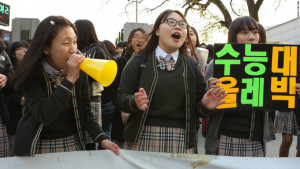 The highly disciplined nature of South Korea’s education system paid off immensely, and both economically and socially: Elementary school enrollment increased from 1.4 million to 5.7 million between 1945 and 1971; between 1945 and 1970 high school enrollment increased from 40,000 students to 2.3 million. In terms of higher education (once virtually a non-possibility for many Koreans) now 80% of High School students continue on to college (compared to 22% in 1945). South Korea is able to now boast a nearly 100% enrollment rate through High School. Internationally, South Korean students are lauded for their test scores and dedication.
The highly disciplined nature of South Korea’s education system paid off immensely, and both economically and socially: Elementary school enrollment increased from 1.4 million to 5.7 million between 1945 and 1971; between 1945 and 1970 high school enrollment increased from 40,000 students to 2.3 million. In terms of higher education (once virtually a non-possibility for many Koreans) now 80% of High School students continue on to college (compared to 22% in 1945). South Korea is able to now boast a nearly 100% enrollment rate through High School. Internationally, South Korean students are lauded for their test scores and dedication.
The focus on education maintained through each of the subsequent Republics following liberation from the Japanese contributed greatly to the nation’s increased economic output. In the latter half of the twentieth century, South Korea became a remarkable success story; transitioning from a country torn with poverty in 1945 to a member of the OECD by 1996.
The Asian Financial Crisis of 1997– instead of putting a damper on the education boom — only added fuel to the fire, as many families realized the security a college degree could provide. A degree from a top university ensured a social status and job security that could better weather the economic struggles of the time.
Through all of the economic turmoil and success, South Korea also saw many incarnations of the CSAT. Originally, individual colleges ran their own entrance exams; however, in the early 1960s the state began to reinstate state-run College entrance exams. The tests transformed with each Republic but maintained their significance as the gateway to a good future. The current version of the CSAT was introduced in 1994, and is written and scored by the Korea Institute for Curriculum and Evaluation (KICE).
As earlier stated, a good score on the CSAT is the pathway to a spot at in a top university, and overall a more comfortable life — much like the Gwageo of the Joseon Dynasty. South Koreans still understand education as a major factor — if not the major factor — for social mobility. As such, families pour millions and millions of won into private schooling in hagwons, fighting to give their students the most — and best — preparation possible to pass the CSAT.
Ironically, whereas the Gwageo was established to prevent the same few families from dominating the government, the CSAT in many ways only reinforces the socioeconomic divide between those who can afford private education, and those who can’t. This is one of the major downsides of the massive success of South Korea’s education system: competition for university positions has only increased, while the status assigned to higher education has not.
The Current Struggles of South Korean Education
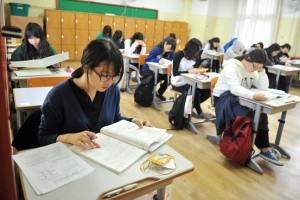 It’s a classic model of high investment high results, but at what cost?
It’s a classic model of high investment high results, but at what cost?
With the reliance on private education in order to pass the CSAT, as well as the increase in college enrollment, the costs and competitiveness of South Korean education continues to rise. Hagwons continue to charge more to parents who can afford it to teach students how to “beat the test.” Additionally, the education craze forces many teachers to push and rush through material in school, and reliance on hagwon continues to increase not only as a means for students to stay ahead, but simply to keep up with curriculum.
Ironically, for all the fierce competition and emphasis placed on getting into a SKY University, none of Korea’s universities rank in the top 100 world universities in various University Ranking systems. Additionally, though South Korea boasts one of the “best” education systems in the world in terms of test results (2nd place after Finland), the country ranks 24th out of 30 developed countries in terms of “study effectiveness.” Meaning, the amount of time Korean students spend studying is disproportionate to the amount they learn.
Even more worrying, is that the South Korean education system is often criticized for its focus of rote memorization as opposed to the promotion of critical thinking. This explains why South Korean students can out-score native speakers on English grammar questions while at the same time they can hardly hold an English language conversation. While many international politicians praise South Korea for its test scores and motivated students, many of the same politicians fail to see the actual toll such a grueling education system takes on the children who endure it.
What this goes to show is that, while there is incredible motivation to be well educated — or at least a strong competitive drive — the system in many ways is still failing to make the most of all the effort being put in by students.
Returning to the CSAT itself, every year the South Korean Government discusses the need to downplay the importance of the CSAT — and universities reliance on it — as well as ‘considers’ the idea of offering the test more often than once a year. However, the next year the test rolls around with few changes, aside from perhaps decreased difficultly.
In the weeks following the CSAT we can expect to see some protests by students regarding question wording– especially in regards to the English section — and perhaps a few stories of students caught cheating on the exam. Hopefully, this year will be less noisy than last year, where a few inaccurate questions lead to a nationwide change in scoring, multiple apologies and ultimately the resignation of the KICE exam chief, Kim Sung-hoon.
On a final note, though it seems daunting, best of luck to all idols and students who took the exam today. In reality, the CSAT is nothing more than a test, but the students who work hard for this moment deserve all the support and well wishes they can get.
(The Korea Times: [1] [2], The Korea Herald, WENR, Terri Kim: Confucianism, Modernities, and Knowledge: China, South Korea, and Japan, CBS News, Michael J. Seth: Education Fever: Society, Politics, and the Pursuit of Schooling in South Korea, PRI, Washington Post, 3WM, The Hankyoreh, The Economist [1] [2], CNN, The Conversation, ICEF Monitor, Chung Yon-tae: Koreans’ Colonial Experience under Japanese Rule and Their Pursuit of Modernization. Jung-Hoon Jung: Hakbeolism: A Historical and Curricular Consideration of Korean Test-Focused Education Images via Getty Images, CNN, News1, Nate, JYPE.)
